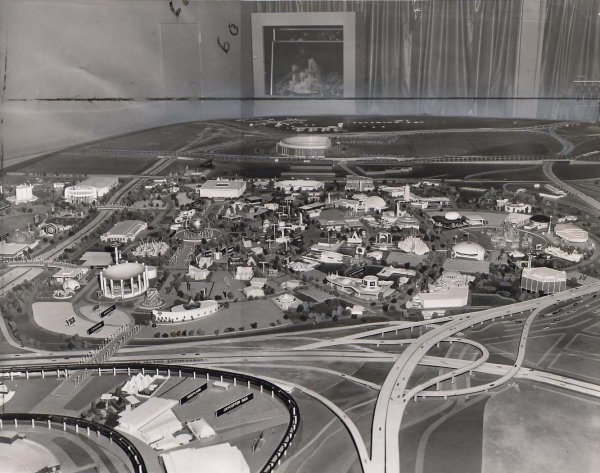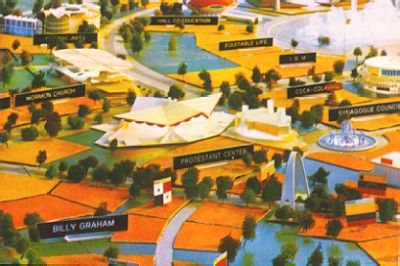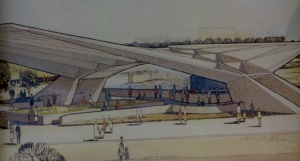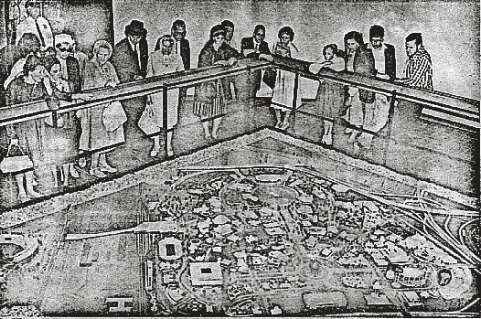|
One of the things that
Robert Moses and his associates had learned early in their careers
was that if you wanted to build something really big one important
way to garner support for the project, as well as to assist the
builders during the planning stages, was to commission a very
detailed model. Never was this truer than for the models that
they had built to both illustrate and publicize the New York
World's Fair of 1964-1965. And according to Moses, the self avowed
model man per his own notes in the Fair records, there was no
better way to attract exhibitors to the Fair and build excitement
with the public than to have a large and dramatic visual representation
of what great and exciting things were coming to the Fair.
A Big Model for a Big
Fair
The model which ultimately
came to be referred to as simply "the big model" became
the responsibility of Deputy Director of States Exhibits Mike
Pender on January 3, 1961 by a memo issued by Robert Moses. But
the story of the model began much earlier than that with the
original proposal that Lester Associates, Inc. made to the Fair
Corporation on August 3, 1960 in which they state that the basic
model map (not including any buildings) would cost $40,500 to
build. As soon as the Fair took possession of the model, the
almost constant updating of it to reflect the changing landscape
began immediately. As new exhibitors signed their leases the
selected plots were marked on the big map to indicate where they
would be located. The map itself was color coded similar to the
later official published maps of the grounds to indicate the
five different exhibit areas of the Fair along with roads being
marked in brown and park areas in green.
From early 1961 until early
1964 Mike Pender was charged with the task of communicating with
Lester Associates to obtain bids for the building and installation
of the various structures in miniature. As plans were announced
Mr. Pender would then work with the engineering and publicity
departments of the Fair to obtain the drawings, sketches, specifications
and artist renderings of the buildings to provide to Lester to
bid the work, and for Lester's artists to ultimately use in constructing
the accurate representations of the structures. Once Lester received
this information they would provide a bid to the Fair which would
be reviewed and approved by Mike Pender prior to work commencing
under a standing contract that they had with the Fair. At regular
intervals time would be reserved for Lester's people to have
exclusive access to the model room to install the new or updated
structures on the big model. The flow of information back and
forth between the Fair and Lester was continuous as new leases
were signed, exhibitors' building plans announced, revised or
ultimately scaled back and even sometimes dropped from the Fair.
Once a lease was signed usually a small plaque would be placed
on the corresponding lot on the model. Then as exhibitors formalized
their building plans those details would be provided to Lester
to build a scale model of the pavilion in miniature. The typical
cost of rendering each of the pavilions usually cost less than
one hundred dollars for the smaller ones such as SKF or Morocco.
The slightly larger pavilions such as Illinois or New Mexico
typically cost one to two hundred dollars. The really large exhibits
such as IBM or GE would routinely cost between three and five
hundred dollars each to build. One unusually complex model was
the Chrysler pavilion which ended up costing the Fair the sum
of $921 initially plus another $215 for changes when they ultimately
finalized their pavilion designs. Installation was extra and
billed based on the actual hours spent on the big model doing
the work.
The model as it appeared on display
in the Administration Building
 |
An example of the great
attention to detail was whether to build an animated or stationary
version of the Monorail. Lester estimated that to build an animated
version would cost $800 whereas a stationary version would only
cost $350. After some discussion back and forth as to the importance
of this exhibit it was ultimately decided that the animated version
would be built and so it was ordered. One has to keep in mind
that all of these amounts are in early 1960s dollars so they
were no small sums even back then. Another interesting story
that illustrates how seriously the Fair and ultimately the exhibitors
viewed the importance of the big model and its timely, as well
as accurate, representation of their plans is reflected in the
communication back and forth between the CEO of the Parker Pen
Company and the Fair. After a visit to the model room the CEO
was quick to dash off a letter to Fair officials demanding that
they immediately update the model. He most emphatically stated
that he felt that they had already had an adequate amount of
time since Parker's participation announcement to update the
model with their exhibit building as well as the narration that
the hostess provided to visitors. Of course the Fair responded
quickly that they too felt this was of the utmost importance
and expected that within no more than eight weeks, or sooner
if possible, the necessary changes would be made.
Lost but Not Forgotten
The big model was also
the only place that some of the unbuilt pavilions at the Fair
would ever be seen. This included the infamous World of Food
pavilion at the main entrance to the Fair, the American Indian
pavilion and the Graphics Arts pavilion to name but a few. One
of the most notable and well documented ideas which never came
to fruition was the Arch of the Americas. It appears that as
early as April 2, 1963, Owens Corning, which was involved with
Marinas of the Future in building the World's Fair Marina, was
very interested in acquiring their own full scale version of
the big model to display in their showroom in midtown Manhattan.
They were duly referred to Lester who quoted them the tidy sum
of $60,000 to build a basic flat model which included only sixty-three
of the pavilions designed and built to date! If they wanted the
model with the same contours as the actual Fair site the cost
would increase by another $7,500; with sound, another $5,000
on top of that. There is no indication that this version was
ever built. But what did come out of this discussion was their
interest to be involved with the Fair on the same level as that
of US Steel. To that end they proposed building an arch entirely
out of fiberglass and for them to receive, in return, a considerable
amount of publicity at Fair expense for sponsoring the construction.
For a short period of time this idea intrigued officials including
Moses who went as far as to direct Mike Pender to have a miniature
model of the arch designed and built for the big model to see
how it would look. While it does appear that the model arch was
built and actually placed on the model its display there was
short lived. This was due in large part to the Fair's unwillingness
to provide the requested level of publicity for the arch for
Owens Corning as they did for US Steel. So the arch came off
the model as quickly as it went on.
SOURCE: World's
Fair Progress Report #8, April 22, 1963
|

The model was truly a
"working model" and was changed all the time. Black
placards with the name of the pavilion, along with a cut-out
"footprint" of its plot, represented the exhibitor
until a model could be constructed. Site cut-outs were color-coordinated
by "area" of the Fair (you can tell the orange International
Area plots from the gold Industrial Area plots at-a-glance, etc.)
This photo is a good example of how the model changed. The archway
in the lower center of the picture is "The Arch of the Americas"
that was never constructed. The model was removed when plans
were dropped. Likewise, the building in the center of the photo
with the cantilevered four-point roof is called The World's Fair
Assembly Building. It became known as the World's Fair Pavilion
and took the shape of a geodesic dome. The dome would replace
the four-point building in later photos of the model.
|
Let There be Light!
When the model was originally
built the structures were not lit from within. As time progressed
Moses decided that the big model needed a very elaborate lighting
system to highlight each structure individually or in groups
corresponding to the five sections of the Fair. At the same time
parts of the model were also painted using phosphorescent paints
to simulate what the Fair would look like at night. This elaborate
retrofit alone cost in excess of $5,000 to complete and included
the addition of black lights in the ceiling above the model to
simulate a night view. As more and more buildings were completed
the lighting system had to be upgraded to meet the power demands
for all of these lights. This was accomplished by adding more
powerful transformers under the model. The lighting effects were
controlled from what can best be described as a complex switchboard
mounted on one side of the model which the operator could switch
on and off in various combinations to produce the desired effects.
All of this lighting caused an unforeseen problem in the close
quarters of the model room. An incredible amount of heat would
build up under the model if left fully on for long periods of
time. This became quite apparent one day when a small wisp of
smoke was noticed coming out from the underside of the model!
Alarmed, Fair officials promptly summoned Lester down to the
Fair site to determine what was causing this very worrisome problem.
Their inspection of the underside of the model revealed that
poor ventilation was allowing the steady build up of heat from
the continuous operation of the lights. This excessive amount
of heat was overloading the circuits and thus causing them to
smolder. Lester promptly recommended that more vents and some
small fans be added at various points along the skirt lining
the model to improve air circulation and that a timer be added
to the light board so that after a certain period of time the
lights would automatically shut off if left unattended. Most
importantly they chastised the Fair for storing various items
underneath the model which they felt was a serious fire hazard.
The Fair Corporation swiftly agreed to these recommendations.
Thus the model was saved from its own imminent and what would
have been a most untimely demise.
Presenting Unisphere (please
stand back though)
On March 24, 1961, General
Potter indicated that Moses had approved the spending of $8,000
to build a 3'9" replica of Unisphere by an unknown firm
on the west coast of the United States. This model ultimately
had its own separate display area in the Administration Building
surrounded by a curtain backdrop and a railing to keep visitors
from getting too close to it. Access to this room was very tightly
controlled with strict instructions to the World's Fair Maintenance
personnel that they could clean everything around and attached
to the model but that under no circumstances were they ever to
actually touch the model for any reason. The records do detail
though how it was once moved to be photographed and filmed by
US Steel for publicity purposes prior to the opening of the Fair.
The memo goes on at length as to what care was to be used in
its handling during the move back and forth from a conference
room where the shoot was to occur. Also of interest is the mention
of how a study was done using this same model to determine that
to have lighted and moving satellites on the three orbit rings
of the real Unisphere would cost anywhere from $100,000 to $150,000
to design and implement and that such a cost would not be practical.
This very novel idea died a quiet death. Just as interesting
though, the records do not detail whatever happened to this very
elaborate and expensive model of the Unisphere after the Fair.
Almost Done, Now What?
What is also interesting
to note about the big model is that while it was not actually
finished until early March 1964 it was at the same time in great
peril of being put in storage or worse yet destroyed unless another
suitable location could be found to display it in. This was because
as the Fair administration staff grew in size so did their need
for suitable and conveniently located office space. The biggest
group in need seemed to be the accounting staff which was growing
exponentially along with the Fair. Since the accountants obviously
were not model men one of the first places they decided to look
to take over was the model room. And so through a good part of
1963, while work still continued on the model, one group of Fair
officials was plotting and scheming against the model while another
group was feverishly working on a plan to find a suitable permanent
home for what was now a very elaborate and very expensive rendering
of the Fair.
Early during this process
it was proposed that a small sponsored pavilion be built at the
main entrance to the Fair and that the model would be lent to
that sponsor free of charge to display in this unique building.
The model would serve as the focal point of the exhibit to help
orientate visitors as they entered the Fair. Fair officials went
as far as to commission a structure designed by no less than
Edward Durell Stone that can best be described as a very graceful
ribbed wing-like permanent structure that was to be set below
grade. A picture of the rendering of this proposed structure
exists in the records and was obviously shown to prospective
sponsors to entice them to participate in the Fair. Fair officials
estimated that such a building would cost anywhere from two to
three hundred thousand dollars to build not including outfitting
the sponsors own exhibit space and staffing it. They also indicated
to all prospective exhibitors that while use of the model would
be offered most generously free of charge, the moving of it would
not be free and as such anyone interested in this idea would
have to bear the entire cost of moving the model out of the Administration
Building and into its new location. William Berns, who was in
charge of publicity for the Fair, made this one of his pet projects
to bring to fruition and Moses gave him until July 1, 1963 to
get it done. During that time the lead contender to sponsor the
pavilion was CBS. A constant stream of unsuccessful correspondence,
which included invites out to the Fair site, was directed personally
to William Paley who ran CBS. At the same time at least a half
a dozen other companies, including Eveready Battery and Wonder
Bread, were contacted as possible sponsors all with no success.
Proposed pavilion designed by
Edward Durell Stone that would display the model of the Fair.
No sponsor was found and the structure was never built.
SOURCE: unknown,
contribuion of Gary Holmes
 |
RCA was also approached
to add the model to their pavilion but they quickly indicated
that at this late stage it was not possible to modify their pavilion
to accommodate it. Things were actually starting to look desperate
as extension after extension was granted until, at almost the
last minute, Mike Pender somehow convinced American Express to
take the model. In a handwritten note at the bottom of one memo
Bill Berns marveled at how Mike pulled it off and promised to
take him for a steak dinner in the restaurant of his choice for
saving the day! And so a deal was struck with Amex for delivery
of the model to occur no later than March 1, 1964. But the model
was not out of the woods yet since even at this late stage it
was far from complete. In the waning days of 1963 and early 1964
there was a flurry of activity between Mike Pender and Lester
Associates as they worked closely together to get the last of
the buildings completed and installed on the model in preparation
for its delivery to American Express in its final form. Then
to add insult to injury, once the model was completed, it was
discovered that a small portion of the original outlying land
areas around the Fair had to be removed and put into off-site
storage by the Fair Corporation never to be heard from again.
This was due to the space limitations for the model at the Amex
pavilion.
SOURCE: Going
Places, May - June 1964
|

The model as it appeared
on display in the American Express Pavilion
|
What the Fair's records
don't indicate is what ultimately happened to the big model after
the Fair. While there were a few pieces of correspondence mentioning
various ideas to move the model back to the Administration Building,
the New York City building, the Hall of Science and even the
Press Building after the closing of the Fair, there is no real
solid evidence documenting that any of these ideas were actually
carried out.
He Who Signs the Checks
Gets the Freebies
Another side note to the
big model was that Robert Moses, Stuart Constable and General
Potter all received mounted versions of various unnamed pavilion
models as gifts from Lester for their desks and offices. At the
same time, on March 23, 1964, Moses directed that plaster models
also be built in 1" to 100' scale and mounted on walnut
bases with engraved nameplates. A total of twenty-five of these
types of models were ordered. The models which came in white
gift boxes were ordered for each of the eighteen state pavilions
at the Fair in addition to six of the New England States model
because it was a multi-exhibitor pavilion, and one of the US
Pavilion, with the idea of presenting them to officials as a
memento of their exhibits at the Fair. Lester priced these special
models at $30 each. One has to wonder whatever happened to each
of these unique models as well.
Have Model Will Travel
It was decided during the
pre-Fair period that in addition to the big model there would
also be a number of much smaller but no less detailed versions
that would be utilized to promote the Fair. To that end the Fair
initially had a grandiose plan to build anywhere from fifteen
to fifty of these smaller "traveling" versions of the
Fair model, the first of which ultimately cost the Fair Corporation
$9,850 to build according to a May 9, 1963 letter from Lester
Associates. In that same letter the Fair was given an option
to acquire six more traveling models for an additional total
cost of $38,600. After paying the cost for the first traveling
model though, plans to build more of these table top type models
stalled for unknown reasons. That was until November 19, 1964
when Lester offered to build the Fair another model for $4,948.
In anticipation of the promotional needs of the Fair for the
1965 season the Fair duly commissioned this additional version
thus giving it two traveling models for its use. During the period
between the above mentioned dates Lester also wrote a number
of letters to Fair officials trying to interest them in a program
whereby Lester would build a number of additional models and
then administer a rental program of their own design for these
other models. The bottom line of their very detailed proposal
ultimately centered on them renting these models out on a weekly
basis for the outrageous sum of $200 per week! Fair officials
thought just that and told Lester that maybe they could get $50
a week. Thus due to this disagreement on what to charge for the
rental program it never got much past Lester building four additional
models at their own cost and renting them for an undetermined
amount on a periodic basis.
Now this is where the story
gets interesting because the records do detail exactly what happened
to all six of these traveling models after the Fair ended! Fast
forward to early 1966 and we find our hero Moses trying to scrape
up every nickel he can lay his hands on to finish Flushing Meadows
Park. When low and behold the Plumbers Union comes along and
offers to buy one of the models for a small but reasonable sum.
Moses, ever the shrewd businessman, offers to sell them one of
his models for the sum of one thousand dollars. The plumbers
being even shrewder than Moses though quickly but politely decline
to take him up on his most generous offer since that is a lot
of money to pay just so some union delegate can say he has one
of the models in his office. Now more time passes and on March
8, 1966, Lester writes to the Fair Corporation and notifies them
that since they built the four models in their possession on
their dime they intend to keep one for themselves, donate one
to the Department of Parks and donate one to the Museum of the
City of New York which leaves one model to be disposed of. Knowing
that they made a boatload of money off the Fair for the big model,
the traveling models and, lest we not forget, The Panorama of
the City of New York, they ask Fair officials if they have any
preferences as to who should be the lucky recipient of their
final model before they decide for themselves. On March 16, 1966,
Moses says in a memo to Stuart Constable that he has already
decided that the Fair's two traveling models are going to the
Long Island State Park Commission and the Triborough Bridge and
Tunnel Authority. At the same time he recalls the plumber's request
and now realizing that he can satisfy their desire to obtain
a model in what can best be described as a declining market for
traveling Fair models, he generously tells his associate to instruct
Lester to send their last model to the plumbers. And so on March
21, 1966 Stuart Constable wrote to Lester Associates and advised
them that Mr. Moses would like them to give the last remaining
traveling model to the Plumbers Local Union #1 for their viewing
pleasure.
And so goes the saga of
the models both big and small of the New York World's Fair of
1964 -1965.
|